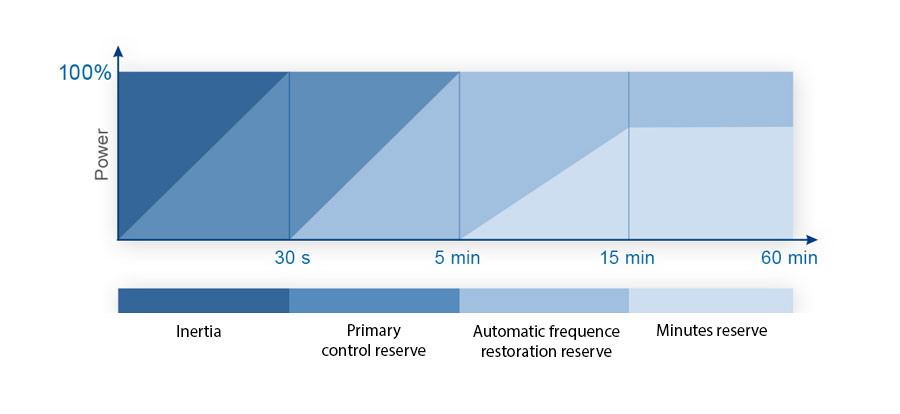Control Power
In order to maintain the power balance TSOs need control power in variant qualities. Control power is traded in an open, transparent and non-discriminatory market, operated by the TSO. The possibility of pooling technical units allows even small providers to participate in the tender. The markets are liquid.
The various system services products of the balancing market can be classified in terms of their temporal activation as required as well as their temporal utilization.
Energy storage is ideal for providing primary control reserve (PCR) and automatic frequency restoration reserve (aFRR). A demand for balancing power arises as soon as the sum of the current supply differs from the sum of current consumption. This divergence causes fluctuations in the frequency. The TSO’s most important rule criteria therefore is the frequency of 50 Hertz. The aim of the TSO is to keep this rate within a certain range at all costs. Therefore, control power is required within the frequency regulation in order to maintain network stability.

Operating reserve
The operating reserve held in case of a power failure of up to 3 GW in the European electricity network is currently being held through the kinetic energy of the generators in conventional power plants. The expected gap caused by the reduction of power plants can be covered to the greatest extent by the existing analog windinertia of the installed wind turbines. A liquid market for the operating reserve is not to be expected in the future.
Primary Control Reserve (PCR)
The constantly evolving demand for PCR stands in opposition to a shrinking supply from the traditional power plants. This creates a gap in supplies of up to 80% of the annual share. In spite of the employed countermeasures about 30% of the annual tranche will have to be covered by alternative providers. Battery storage systems are now the most inexpensive alternative in order to cover this gap.
Automatic Frequence Restauration Reserve (aFRR)
aFRR represents the transition from the very short-term PCR to the equalizing minute reserve. Accordingly, the requirements are diversified. Only few other producers/consumers are suitable for prequalification. A potential gap as a result of the reduction of conventional power plants can be easily balanced out by means of battery storage systems.
Minute Control Power
Minute control power complements aFRR and is tendered at short notice. Due to the constant expansion of renewable energies, the demand will increase significantly. Numerous providers can qualify more easily for this system service significantly than for aFRR. Energy storage systems can provide selective support so as to utilize short-term market potential.
Real-time reading of frequency and control power
Why control power?
Electricity must still be generated at the same time as it is consumed. Whether this balance exists can be seen from the grid frequency. If the grid frequency is lower than 50Hz, then more electricity is being consumed than the power plants are generating. If the grid frequency is above 50Hz, then more is being fed in than is being consumed.
